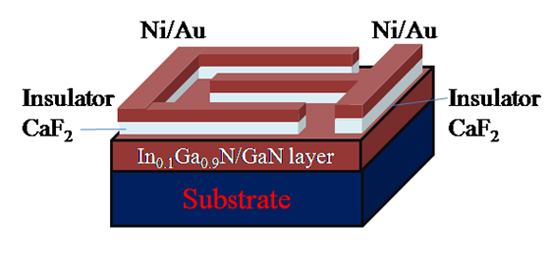High Sensitivity in InGaN UV Sensor by Development of CaF2 Insulation Layer
2011.03.04
National Institute for Materials Science
The NIMS Sensor Materials Center succeeded in the development of a detector for ultraviolet light in the A range (UVA; wavelength: 320-400 nm), which occupies 95% of the UV spectrum, satisfying both high sensitivity and fast response.
Abstract
- A research group headed by Dr. Masatomo Sumiya, Principal Researcher, and Researcher Liwen Sang of the Sensor Materials Center (Managing Director: Hajime Haneda), National Institute for Materials Science (President: Sukekatsu Ushioda), succeeded in developing a detector for the ultraviolet-A range (UVA; wavelength; 320-400 nm), which occupies 95% of the UV spectrum. The new device, which satisfies both high sensitivity and fast response, was developed by inserting calcium fluoride (CaF2), which is an insulator between a group III-V nitride thin film and a Schottky metal electrode.
- Group III-V nitride thin films have the feature of enabling selection of the UV wavelength being detected by controlling the mixed crystal ratio of group III elements (Al, Ga, In). InGaN thin films are suitable for the detection of UVA. However, due to their high dislocation density and residual carrier concentration, they have the problems of increased leakage current and continuing photoelectric current after irradiation, which had made it difficult to develop UV sensors which simultaneously satisfied a high sensitivity difference for UV and visible light and fast response. In devices which used Si as the UVA detector up to the present, low sensitivity due to small bandgap had been a problem.
- In this research and development, the NIMS group created a UVA detection device with a metal-semiconductor-metal (MSM) structure, in which a Schottky electrode (Ni (20 nm) / Au (20 nm)) was formed in a comb-like shape on the surface of an InGaN thin film grown by the metal organic chemical vapor deposition (MOCVD) method. By inserting CaF2 , which was fabricated by sputtering, 5 nm between the electrode and the InGaN film, it was possible to realize a low leakage current (<1.4 x 10-7A @ -5V) and high photosensitivity. Although a variety of wide gap materials such as SiO2, Si3N4, p-GaN, etc. had been tested as an insulation layer, none displayed a high insulating property like that of CaF2.
- The InGaN thin film MSM-type UVA detector with inserted CaF2 has a six-order detection sensitivity difference for UV and visible light and provides unprecedentedly high performance. The device displays 10.4 A/W sensitivity (gain: 40) for 338 nm UV at a 2V bias and a millisecond response speed, realizing an approximate six-fold improvement in sensitivity and ten-fold improvement in the detection limit. Although it is still necessary to clarify the role of CaF2, the high response speed of the new device suggests that the interface level is reduced by this material.
- The new device can be used in environmental monitoring of UVA, which easily passes through glass windows and is a cause of stains over extended time periods. Because InGaN and CaF2 are both wide bandgap materials, use in high temperature environments is expected.
- This research achievement will be reported in the scientific journal "Applied Physics Letters" on March 7.

Figure 1 Device structure of the developed MSM-type InGaN UVA detector with inserted CaF2.
